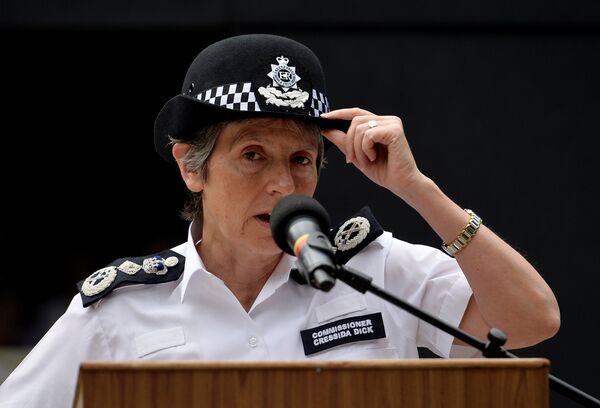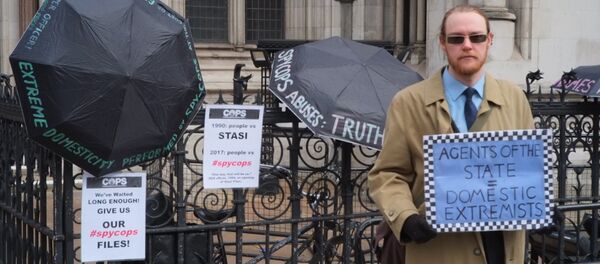While authorities' public admissions did not come replete with a full list of the organizations infiltrated, police chiefs admitted "the majority" related to persons of color — among them many young men who died in custody. Undercover officers, pretending to be concerned members of the public, would approach groups and offer to help out with their campaigns. Here are just some of the groups officers infiltrated.
Colin Roach Center
In some cases, police operatives played crucial, frontline roles in such groups. For instance, under the pseudonym Mark Cassidy, undercover officer Mark Jenner was a key organizer at the Colin Roach Center (CRC), a leading centre of radical activism in Hackney, North London.
The Center was founded 10 years after the mysterious death of Colin Roach inside the foyer of Stoke Newington police station January 12, 1983. Police claimed the 21-year-old had committed suicide, but family, friends and local residents suspected foul play, as he'd been shot in the back of the head.
Jenner turned up at CRC early 1995, attending events and meetings. According to Mark Metcalf, coordinator for the Center, within weeks he'd "thrown himself into virtually every area of the centre's political life" and began writing for its internal bulletin and quarterly magazine.
"As the owner of a van he could also be relied upon to transport people and equipment to meetings and ensure they got home safely afterwards. Always polite and happy to help out, he soon became well liked and respected," Metcalf recalls.
He is said to have taken a particular interest in justice groups there, in particular the campaign behind Malcolm Kennedy, a man wrongfully convicted of manslaughter in Hammersmith Police Station in December 1990. Jenner's pivotal position in CRC would also have allowed him to harvest information on protest actions and other issues of interest to authorities.
Stephen Lawrence
Perhaps most infamously of all, the Metropolitan Police spied on the Stephen Lawrence justice campaign.

A popular campaign quickly took root, seeking to bring his killers to justice, and expose police bigotry and ineptitude — it received overwhelming support from the public, and many politicians and journalists promoted its activities.
In response, the Metropolitan Police dispatched undercover officers to infiltrate the group — among them was Peter Francis, who posed as ‘Pete Black'. He has revealed his mission was to find incriminating information about the campaign, and Lawrence's family and friends, in order to discredit it and them in the eyes of the public.
"Had I have found anything detrimental — and newsworthy — about the Lawrence family, the police, using the media then, would've used that information to smear the family. My superiors were after any intelligence of that order. That was made clear to me. The Lawrences were not unique in this. I would suggest journalists read back some of the information leaked to the press at the time about some these campaigns and seriously question where they came from and why. They should also look back at how some of the tabloids reported the Lawrence death very early on," Peter has alleged.
Stephen's close friend Duwayne Brooks, the main witness to the murder, was repeatedly arrested in the years afterward. In one instance, he was alleged to have fought during an anti-racist march outside the British National Party headquarters in Welling days after the murder. Although Brooks was charged, the judge dismissed the case against him. Information on his activities was said to have come from undercover officers.
Two members of the five-strong gang that attacked Stephen and Duwayne were eventually convicted in 2002.
Jean Charles de Menezes
On July 22 2005, Jean Charles, a 27 year old electrician, was executed by armed police on an underground train in South London.

Two officers then fired a total of eleven shots at Jean Charles at close range, hitting him seven times in the head and once in the shoulder at close range. An eyewitness later indicated the shots were fired over a thirty-second period, at three second intervals. His body was said to be "unrecognizable" afterwards.
When the victim's total innocence was quickly established, the Metropolitan Police immediately began disseminating false information, unquestioningly regurgitated by the mainstream media, in order to lend legitimacy to the killing, and raise questions about Jean Charles own conduct. Suggestions he had acted suspiciously on numerous occasions while being followed, was an illegal immigrant, had wires sticking out of his rucksack, and had vaulted the station ticket barriers despite police demands he stop, were just some of the entirely bogus stories circulated in the weeks afterward.
On August 16 2005, the Jean Charles de Menezes Family Campaign, also known as 'Justice4Jean', was established, calling for a public inquiry into the "unlawful killing". It was swiftly infiltrated by undercover officers, in order to track the progress of their campaign, and construct an effective public response in advance.

Joy Gardner
On August 1 1993, the London home of Joy Gardner was raided by immigration officials. When she resisted attempts to put her in a 4-inch wide restraint belt with attached handcuffs she was shackled, gagged, with 13 feet of adhesive tape wrapped round her head. She rapidly suffered respiratory failure and died four days later.
The case became a cause celebre for civil rights and justice campaigners, and for the first time brought widespread public attention to what human rights lawyer Michael Mansfield called "the inhumanity of methods used routinely in the execution of deportation orders" in the UK. Almost inevitably, her family's campaign group was infiltrated by Special Demonstration Squad officers, in an operation overseen by veteran "spycop" Bob Lambert.

Eventually, three police officers involved in the raid were charged with manslaughter. Four separate forensic pathologists concluded the cause of Joy's death was cerebral hypoxia, caused by her gagging — however, police found another pathologist, Paula Lannas, who was willing to attribute her death to accidental brain damage caused in the struggle. The officers were eventually acquitted.
Later, major questions were raised about the work of Lannas — during a trial at the Old Bailey in June 1998, she testified bruising on the neck of a 16-month-old child "resulted from strangulation by the mother's boyfriend." The defendant was acquitted when forensic pathologist Iain West testified the post mortem examination had been so "cack-handed" the bruising may have been inflicted by Lannas, and the prosecution informed the jury her conclusions were "suspect" and could not be relied on as evidence.
Moreover, in May 2000, two men had their convictions for manslaughter quashed when it was disclosed Lannas had testified at their trial the victim had been killed by a stab wound and had no other injuries. Subsequent examination found a potentially fatal skull fracture. A 2001 disciplinary tribunal found Lannas's pathology work "consistently fell substantially short" of expected standards and there were "substantive deficiencies" in "her technical approach and medical knowledge."
The official use of gags was banned shortly after, but no admission has ever been made that it was part of the cause of Joy's death — and despite continuing pressure by campaigners, no coroner's inquest or public inquiry into Joy's death has been held as of April 2018.
Blair Peach
Blair Peach was a popular local organizer and campaigner based in east London. On April 23 1979, he attended a Anti-Nazi League demonstration in Southall, Middlesex — having broken away from the main demonstration into a side street, he was confronted by Special Patrol Group riot officers, one of whom fractured his skull with a blow from an unauthorized weapon.
Officer Alan Murray — who lied to investigators and refused to take part in identity parades at the time — has identified himself as ‘Officer E', although denies killing Peach. As of April 2018, no individual has ever faced investigation or charge for the death.
Conclusive evidence the Blair Peach justice was directly spied on contemporaneously by police is unforthcoming, but it may be notable Blair's family have been named core participants in the ongoing Undercover Policing Inquiry.




